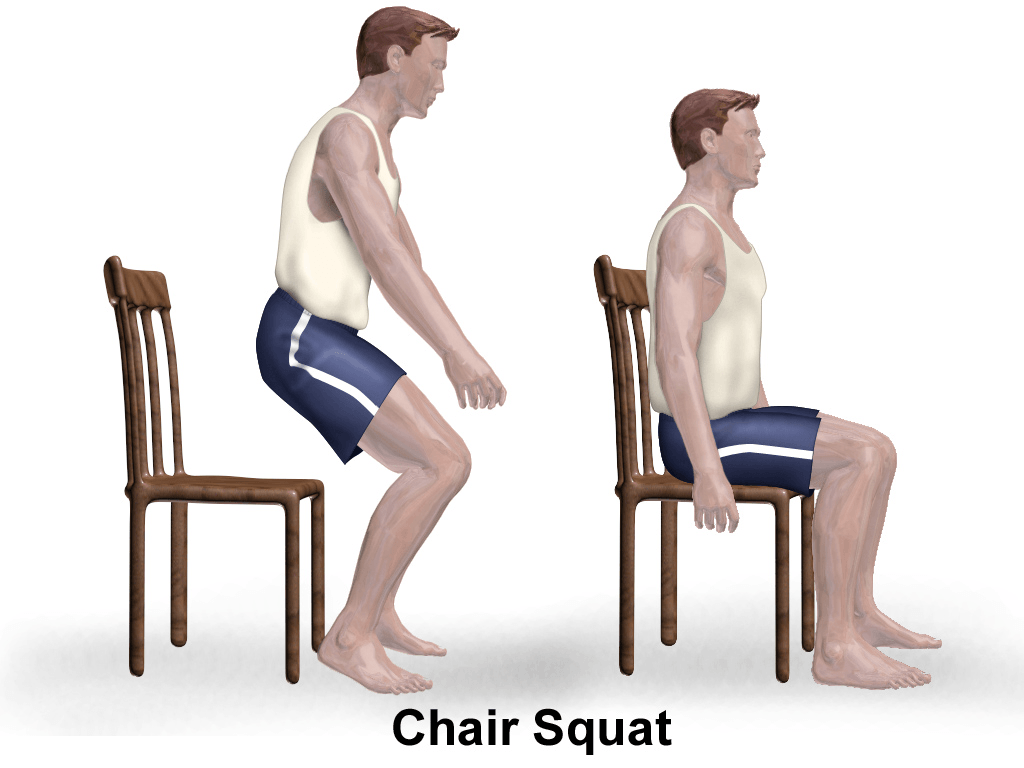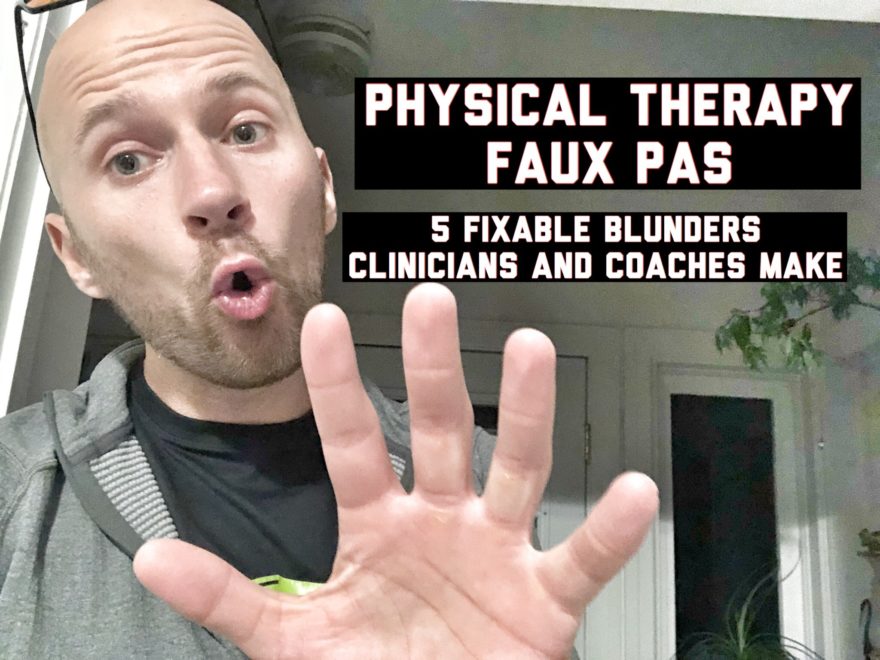Faux Pas: (Noun) An embarrassing or tactless act or remark.¹
I’m not the greatest physical therapist.
I make mistakes, some people don’t get better, some people get worse.
Yet despite my flaws, I’ve done all that I can to minimize as many avoidable errors as possible. Errors that can put maladaptive beliefs into a client’s mind. Errors that can hinder progress.
Sadly, I see many people make these avoidable errors. And I’m not talking therapists only. I’m talking coaches, doctors, chiropractors, everyone.
While we can all agree that clinical errors are expected and unavoidable, many problems can be fixed simply by changing the way we think and communicate with clients. Better communication will lead to greater success for the client one, and better collaboration to those seeking to help said client.
Here are some faux pas to avoid, and solutions to these problems.
Table of Contents
Claiming to be a Fixer
We don’t fix people. Our client’s aren’t broken. We certainly can’t palpate the exact damaged tissue and use an uber-specific manual technique to fix it. Manual therapy likely changes tissues minimally, but alters nervous system response maximally².
We are not fixers, but guides. Facilitators who allow clients to heal themselves.

Specific client problems can’t be seen as dysfunction. The body is smarter than that. Given all of the past, present, and anticipated future internal and external stressors, the supposed “dysfunction” is likely the best thing the body can do to ensure survival. We wouldn’t have evolved this far if we were a bunch of dysfunctional people (though my family reunions might suggest otherwise)³.
Our job is to provide a safe environment for our clients to alter their current strategy. To adopt a favorable strategy that returns one to homeostasis. Allowing the body to heal repair, and thrive.
These environments can range from movement, meditation, nutrition, sleep, and even surgery. Yes, surgery. You don’t just get a total knee and consider yourself Gucci, otherwise everyone would be immediately better. Instead the knee environment is changed such that nociception is reduced, and a good post-operative plan can allow the client to discover a different movement strategy.
Solution
You are a facilitator. A guide. The “fix” is in the hands of the client/patient.
Oh, Let Me Communicate through the Patient and Hope for the Best
You ever play the phone game as a kid? Someone starts by telling a kid one thing. That thing is then passed along to the next kid and the next until it gets to the last kid. Usually, the end result is drastically different. Hilarious as a kid? Absolutely. Funny hearing it from a client? Ehhh….

Sometimes patients tell me atrocities that supposedly doctors or other therapists said. Most of the time (I hope), what is said is likely an inaccurate representation of what the clinician meant.
Communicating through patients/clients leaves everyone frustrated. The therapist is frustrated because the doctor said squatting is bad for the knees. The strength coach is ticked because the therapist said the shoulder must stay packed with pressing. And the client is pissed because he or she is not getting results.
Interdisciplinary dialogue is essential. Many problems could be solved by just talking through concepts, even if there is a fundamental disagreement. Likely both parties will learn something if attentive listening is practice, and the client will likely attain better results.
However, I understand how the healthcare landscape makes communication challenging. Electronic medical records take so much time to complete keep, patient sessions are incredibly short, and heavy paywalls exist for evidence-based practice. Not only that, be we have lives too, fam.
Simple fix? If you can’t take the time to call or text, at least document clearly steps to be taken and why. I can’t tell you how many times I’ve had a post-surgical patient without a protocol, or how many coaches reach out to me saying a therapist said “don’t do x, y, and Z” without helping the coach understand why. A short note explaining particular decisions can reduce tension among practitioners, open the door to professional conversation, and ultimately provide better service for the client.
Solution
Talk to each other in some way, shape, or form.
Demonizing That which is Not in Your Skill-set
I’m not the guy you want to learn Olympic lifting from. I know minimal about it, how to coach and cue effectively, and how to pick apart movement inefficiencies. Hell, I can’t even get enough shoulder flexion to perform the dang things.

If an Olympic lifter hurts while performing a snatch, the last thing I want to say is “don’t do that.” It’s not my place because I don’t have a thorough graps of technical execution. I cannot rule out a technical issue, but someone else might.
You shouldn’t squat with your knees past your toes says the doctor, yet has never attempted a loaded squat. A clinician says flexion is bad, yet can’t coach an exercise in a safely flexed position. I can’t help you with this, therefore, it’s bad.
False.
Instead, we either must broaden our scope or find colleagues who complete our incomplete skill-sets. Maybe I can’t help you with the snatch, but Rufus in Indy certainly can. Or maybe I can spend some time studying the lifts so I can better help you. That is the key to problem solving for clients. Something is only bad until you can find someone who can make it good.
Solution
Nothing is inherently bad (except cyanide and injectables, them shits will kill you). Broaden your scope or find colleagues who fills your gaps.
Creating a Story to Explain Symptoms
That forearm pain you just started getting? I think it’s from your whiplash injury you had four years ago. That tingle you have in your lower back? All of your disks have disintegrated. You have an itch on your face? Remember when your father spanked you as a child?
These are examples of many gross oversimplifications of complex problems. Any output an individual has, whether it’s pain, anxiety, anger, or joy, results from the summation of past experiences, internal and external inputs, and may other factors we are likely unaware of. Even in simple cause and effect cases such as an in-game ACL tear leads to idiosyncratic amounts of pain and swelling.
Moreover, associating pain with a specific story can be especially problematic with clients who have persistent pain. Pain felt during a particular task may make uneducated clients think that they are being injured every time they feel pain.
Not only is this scenario harmful, but it’s an inaccurate representation of the relationship between pain and injury. Perhaps that very same movement becomes pain-free when that individual performs the exact same task three days later in a lower stress environment.
No two injuries are the same. There are no classification systems. Nonspecific low back pain is oxymoronic. Each person is unique in internal/external stressors and presentation, and ought to be treated accordingly.
Solution
Realize that the reasons our clients are having problems are multifactorial, and be comfortable knowing we are operating with uncertainty.
Don’t Throw People Under the Bus
I had a patient who had a knee surgery. The surgeon put the fear of god in her, telling her that her knee was fragile and she must take things slow.
I was given a protocol for this specific patient, which said patient wanted me to follow to the T. I’m talking to the exercise, fam.
On the protocol one week was deep knee bends, and a couple weeks later, single leg deadlifts with a ball. Yes, I know.

Clearly, there was a gap in progression within this protocol. This client was just starting to perform squats comfortably unsupported, yet neither of us felt comfortable going with a single leg activity. I elected to have her perform a 30# kettlebell deadlift, what I thought was a reasonable starting point given where she was.
The next session, she came in incredibly upset. Her knee was sore, she asked where in the protocol a deadlift with that specific weight was, and wanted to know how much weight was in the picture with the single leg deadlift (which probably weighed as much as a feather). She was not happy with me.
I apologized and took ownership that I progressed her too quickly. I educated her that though her knee was sore there likely wasn’t tissue damage, sometimes a flare up in symptoms can happen when a progression is attempted, and I promised to scale back to mitigate the flare-up. Seems a reasonable approach, right?
Here was an unreasonable approach. She also happened to call the surgeon’s office, and spoke to the Physician Assistant about what happened. Instead of taking ownership and having the back of a fellow healthcare practitioner, this PA stated that I should not have used that much weight and reaffirmed that nowhere was a deadlift in the protocol.
While I readily admit that I made a mistake in load management, throwing people under the bus to cover your own ass is bad medicine.
We call it practice for a reason. Mistakes are part of the game because every patient encounter is clouded with uncertainty. I bet that if the surgery was unnecessary, the surgeon would not have appreciated me telling the patient that the surgeon made the wrong call, botched the surgery, and should be sued.
We cannot make a judgment call on a practitioner’s decision based on our present clinical environment. Maybe that person made the best decision they could’ve at the time. Maybe they made an error because they were missing a key piece of information. Maybe the problem required a solution that said practitioner didn’t have, but there was no one in the area that could provide that solution.
While we can demand better in all professions, we have to create a supportive and humble environment for coaches and clinician’s to make errors, listen to feedback, and encourage progress. That is the only way performance end medicine can progress.
Solution
Take ownership of what you could have done better in the situation. You can’t control what other people do, and being upset solves nothing. Control what you can control.
Sum Up
To summarize:
- You are not a fixer, but a facilitator, a guide.
- Squash communicating through the patient. Communicate among providers
- Broaden your scope or find people to fill your gaps when encountering scenario’s outside of your skill-set
- Be comfortable operating with uncertainty, and let clients also be comfortable with that.
- Work together, take ownership as a team, and don’t throw each other under the bus.
What faux pas do you see practioners make on the regular? What solution do you recommend? Comment below and let us know #famrecognizefam
References and Footnotes
1. The dictionary, fam.
2. Bialosky et al. The mechanisms of manual therapy in the treatment of musculoskeletal pain: a comprehensive model. 2009. Man Ther;14(5):531-538.
3. I’m just playin’ fam, you know I love you.
Photo Credits
All other images I have rights to. Adobe Stock FTW #dealwithit

